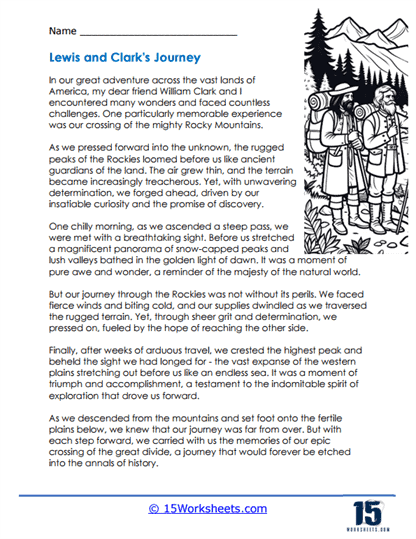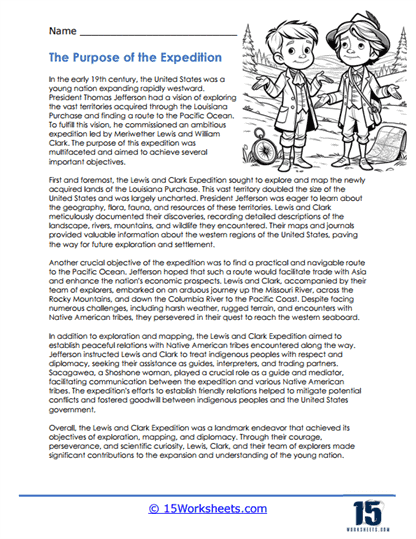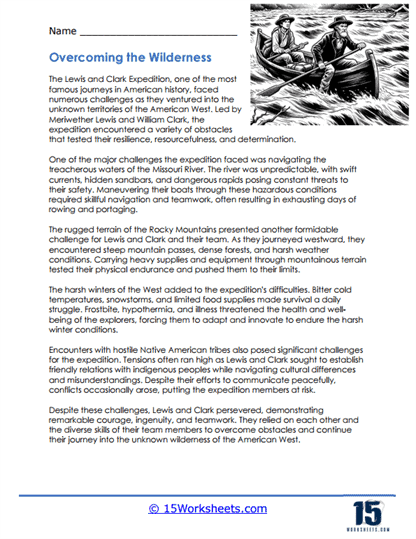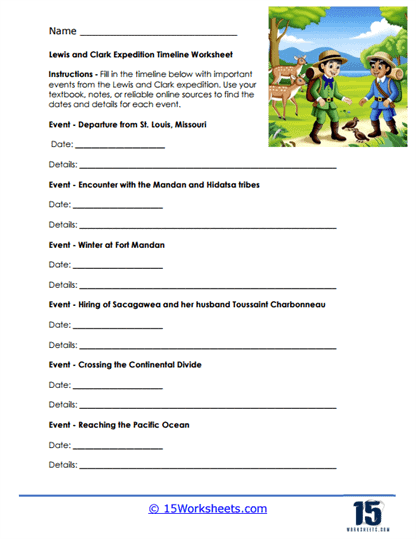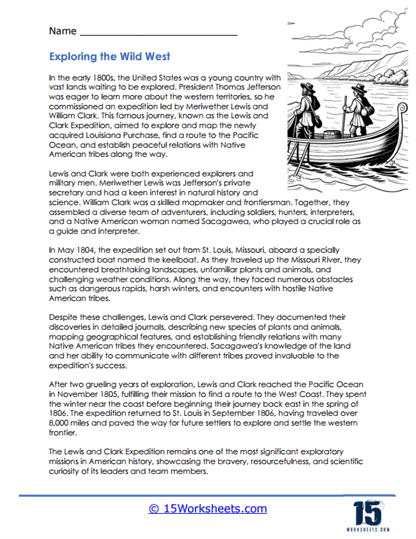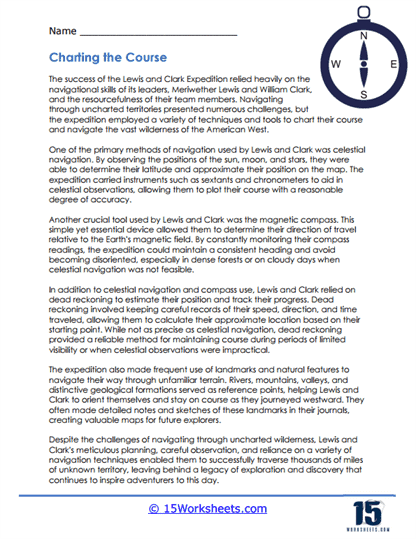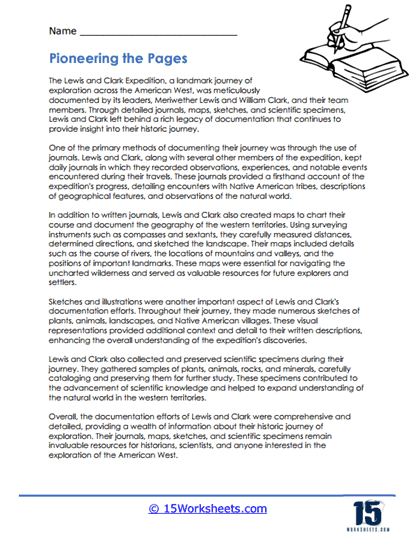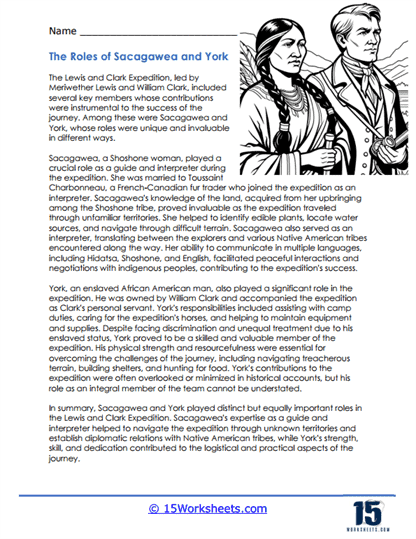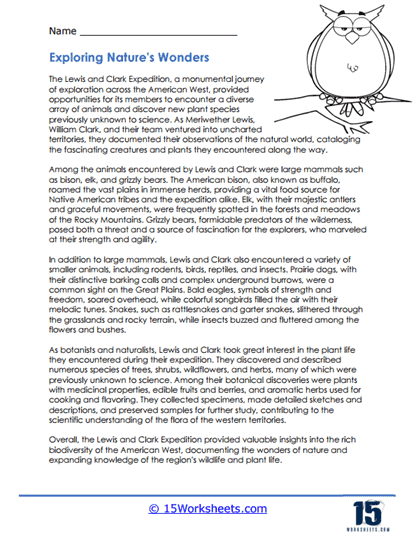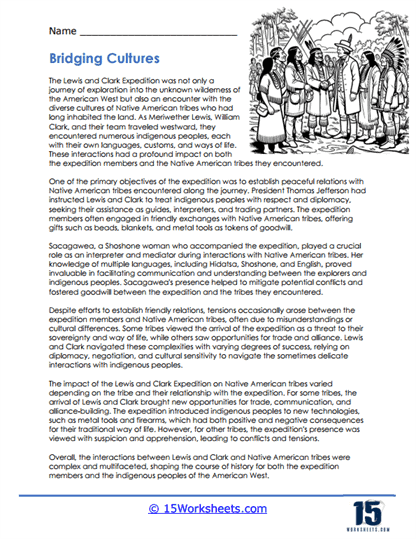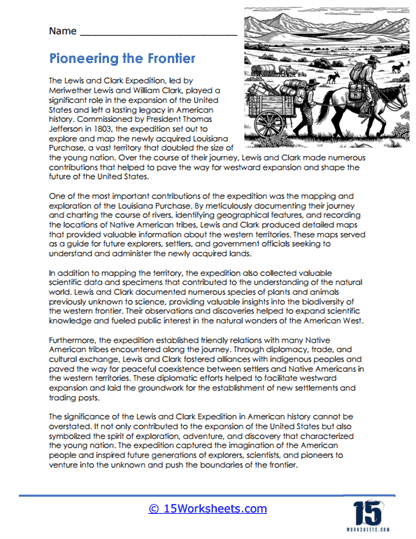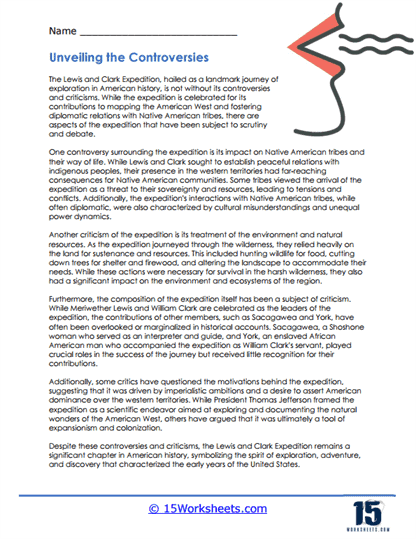Lewis and Clark Worksheets
About These 15 Worksheets
Lewis and Clark worksheets are educational tools designed to enhance students’ understanding of the historic expedition led by Meriwether Lewis and William Clark from 1804 to 1806. This expedition, known as the Corps of Discovery, was a pivotal event in American history, facilitating the exploration of the Louisiana Purchase and the lands west to the Pacific Ocean. The worksheets covering this topic include a variety of exercises that cater to different learning styles and objectives, aiming to deepen students’ knowledge about the expedition, its significance, and its impacts.
Types of Exercises
Reading Comprehension Questions – These worksheets often start with a descriptive passage about the expedition, detailing the events, the people involved, and the goals set by President Thomas Jefferson. Following the passage, students answer questions that test their understanding of the text, focusing on key details, themes, and implications. This practice enhances students’ ability to extract and process information from historical texts.
Timeline Creation – Students might create timelines to sequence major events during the expedition. This helps them understand the chronology and the duration of the journey, as well as the progression of discoveries and interactions with Native American tribes.
Matching Exercises – These exercises typically involve matching terms or descriptions with people, places, or events related to the expedition. For example, students might match a description of Sacagawea with her role in assisting the expedition. Such activities reinforce students’ memory and understanding of key figures and terms.
Fill-in-the-Blanks – Fill-in-the-blank exercises focus on important vocabulary or facts related to the expedition. Students complete sentences or paragraphs by using clues provided in the worksheets, which aids in learning specific terminology and factual content relevant to the Lewis and Clark journey.
Multiple-Choice Questions – To assess understanding of the expedition’s details, multiple-choice questions can cover a wide range of topics, from the scientific discoveries made during the expedition to the political ramifications of the journey. This format helps students recall and review information efficiently.
Essay Writing Prompts – Worksheets may provide prompts for essays on topics like the impact of the expedition on U.S. expansion, the role of Native American tribes, or the scientific contributions of the journey. Writing essays encourages deeper analysis and synthesis of historical data, improving critical thinking and writing skills.
Debate and Discussion Questions – Worksheets often include questions designed for group discussions or debates, such as the ethical implications of the expedition’s impact on indigenous populations or debates on the most significant outcomes of the expedition. These discussions encourage students to articulate their thoughts clearly and consider multiple viewpoints.
The Benefits of These Worksheets
Increased Knowledge Retention – Engaging with varied types of exercises helps cement information in students’ minds, making it easier to recall facts, concepts, and contexts related to the Lewis and Clark expedition.
Skills Development – These worksheets not only enhance knowledge about a specific historical event but also develop a broader set of academic skills. Reading comprehension, critical thinking, geographical mapping, and chronological reasoning are all cultivated through these diverse activities.
Deeper Understanding of Contexts – Through detailed study, students gain insights into the broader context of early 19th-century America, including its geopolitical ambitions, interactions between different cultural groups, and the natural environment of the time. These exercises prepare students for higher-level history and social studies courses by providing them with a strong foundation in researching, writing, and reasoning about historical topics.
Encouragement of Analytical Thinking – By tackling complex topics through essays, debates, and critical thinking questions, students learn to analyze historical events, develop arguments, and support their ideas with evidence. The variety of activities in Lewis and Clark worksheets caters to different learning styles, keeping students engaged and motivated to learn more about history. Interactive and diverse methods help maintain interest and excitement about the subject matter.
What Was The Lewis and Clark Expedition?
The Lewis and Clark Expedition, also known as the Corps of Discovery Expedition, was a significant journey undertaken by the United States from 1804 to 1806. It was the first American expedition to cross what is now the western portion of the United States. Commissioned by President Thomas Jefferson shortly after the Louisiana Purchase in 1803, the primary objective was to explore and map the newly acquired territory, find a practical route across the Western half of the continent, and establish an American presence before Britain and other European powers tried to claim it.
Leaders and Preparation
The expedition was led by Meriwether Lewis and William Clark. Lewis was President Jefferson’s private secretary, chosen for his abilities and knowledge of natural sciences. William Clark was a seasoned frontiersman and mapmaker, providing practical leadership and skills crucial for the journey. The team they assembled, known as the Corps of Discovery, included soldiers, skilled tradesmen, frontiersmen, and Native American interpreters.
Journey
The expedition set out on May 14, 1804, from St. Louis, Missouri, making its way westward along the Missouri River to the Great Plains. They spent the winter of 1804-1805 at Fort Mandan in present-day North Dakota, where they hired a French-Canadian fur trader, Toussaint Charbonneau, and his teenage Shoshone wife, Sacagawea, who proved invaluable as an interpreter and guide.
In the spring of 1805, the expedition continued their journey, crossing the Rocky Mountains with the help of Sacagawea, who identified a pass that would later be named Lemhi Pass. They then descended the Columbia River to the Pacific Ocean. They reached the ocean in November 1805 and built Fort Clatsop on the present-day Oregon side of the river as their winter encampment.
Scientific and Geographic Contributions
The Corps of Discovery collected valuable scientific and geographical data. They documented over 300 species new to science, including plants, animals, and minerals, and made nearly 140 maps. Lewis and Clark were also among the first to provide detailed descriptions of the geography and Indigenous cultures of the Louisiana Territory.
Interaction with Native American Tribes
The expedition encountered numerous Native American tribes, with whom they exchanged gifts, engaged in trade, and sometimes experienced conflict. They negotiated with the tribes for safe passage and gathered information about the region’s political and economic landscape. The diplomatic relations they established were vital for the safety and success of the expedition.
Return and Outcome
The expedition began their journey back to St. Louis in March 1806, arriving on September 23, 1806. The successful return of the Corps of Discovery had profound effects:
Territorial Claims – It strengthened U.S. claims to the Pacific Northwest.
Westward Expansion – It opened vast areas for exploration and fur trade, paving the way for westward expansion.
Maps and Routes – The maps created by the expedition helped set the stage for the settlers who would follow over the Oregon Trail and other routes in the ensuing decades.
Scientific Discovery – The biological specimens and ethnographic information significantly enriched American scientific knowledge.
The Lewis and Clark Expedition is celebrated as a symbol of American exploration and the pioneering spirit of the early United States. It laid the groundwork for westward expansion and deepened the understanding of the continent’s geography and native cultures. The detailed journals kept by Lewis, Clark, and other members remain valuable historical documents, providing insight into this epochal journey.

